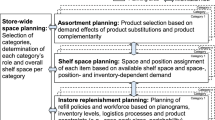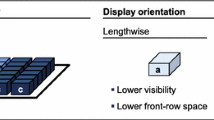Abstract
This paper addresses a problem where a retailer seeks to optimize store-wide shelf-space allocation in order to maximize the visibility of products to consumers and consequently stimulate impulse buying. We consider a setting where the retailer, because of product affinities or the retailer’s historical practice, has pre-clustered product categories into groups each of which must be assigned to a shelf. On the basis of its location in the store layout, each shelf is partitioned into contiguous shelf segments having different anticipated customer traffic densities. The retailer seeks to assign each group of product categories to a shelf, to determine the relative location of product categories within their assigned shelf, and to specify their allocated total shelf space within given lower/upper bounds. We propose a 0–1 integer programme that takes into account expected customer traffic densities within the store, groups of product categories, their relative profitability, and the desirability to keep certain product groups in the same aisle, with the objective of maximizing the impulse buying profit. The proposed model is grounded in a preprocessing scheme that explores feasible assignments of subsets of product groups to available aisles by iteratively solving an  -hard subproblem and is numerically observed to greatly outperform an alternative mixed-integer programming formulation. We demonstrate the usefulness of and the enhanced tractability achieved by the proposed approach using a case study motivated by a grocery store in New England and a variety of simulated problem instances.
-hard subproblem and is numerically observed to greatly outperform an alternative mixed-integer programming formulation. We demonstrate the usefulness of and the enhanced tractability achieved by the proposed approach using a case study motivated by a grocery store in New England and a variety of simulated problem instances.






Similar content being viewed by others
References
Abratt R and Goodey SD (1990). Unplanned buying and in-store stimuli in supermarkets. Managerial and Decision Economics 11 (2): 111–121.
Amrouche N and Zaccour G (2007). Shelf-space allocation of national and private brands. European Journal of Operational Research 180 (2): 648–663.
Bellenger DN, Robertson DH and Hirschman EC (1978). Impulse buying varies by product. Journal of Advertising Research 18 (6): 15–18.
Borin N, Farris PW and Freeland JR (1994). A model for determining retail product category assortment and shelf space allocation. Decision Sciences 25 (3): 359–384.
Botsali AR (2007). Retail facility layout design, PhD Dissertation, Texas A&M University, USA.
Buttle F (1984). Retail space allocation. International Journal of Physical Distribution and Material Management 14 (4): 3–23.
Cattrysse D and Van Wassenhove L (1992). A survey of algorithms for the generalized assignment problem. European Journal of Operational Research 60 (3): 260–272.
Chen YL, Chen JM and Tung CW (2006). A data mining approach for retail knowledge discovery with consideration of the effect of shelf-space adjacency on sales. Decision Support Systems 42 (3): 1503–1520.
Clover VT (1950). Relative importance of impulse-buying in retail stores. Journal of Marketing 15 (1): 66–70.
Corstjens M and Doyle P (1981). A model for optimizing retail space allocations. Management Science 27 (7): 822–833.
Cox KK (1970). The effect of shelf space upon sales of branded products. Journal of Marketing Research 7 (1): 55–58.
Curhan RC (1972). The relationship between shelf space and unit sales in supermarkets. Journal of Marketing Research 9 (4): 406–412.
Desmet P and Renaudin V (1998). Estimation of product category sales responsiveness to allocated shelf space. International Journal of Research in Marketing 15 (5): 443–457.
Dreze X, Hoch SJ and Purk ME (1994). Shelf management and space elasticity. Journal of Retailing 70 (4): 301–326.
Farley JU and Ring LW (1966). A stochastic model of supermarket traffic flow. Operations Research 14 (4): 555–567.
Ghoniem A and Maddah B (2015). Integrated retail decisions with multiple selling periods and customer segments: Optimization and insights. Omega 55: 38–52.
Ghoniem A, Maddah B and Ibrahim A (2014a). Optimizing assortment and pricing of multiple retail categories with cross-selling. Journal of Global Optimization doi:10.1007/s10898-014-0238-3.
Ghoniem A, Flamand T and Maddah B (2014b). Maximizing Impulse Buying via Store-Wide Shelf Space Allocation of High-Impulse Products and Traffic Drivers. Isenberg School of Management, University of Massachusetts Amherst.
Hariga MA, Al-Ahmari A and Mohamed AA (2007). A joint optimisation model for inventory replenishment, product assortment, shelf space and display area allocation decisions. European Journal of Operational Research 181 (1): 239–251.
Hui SK, Fader PS and Bradlow ET (2009). The traveling salesman goes shopping: The systematic deviations of grocery paths from TSP optimality. Marketing Science 28 (3): 566–572.
Hui SK, Inman JJ, Huang Y and Suher J (2013). The effect of in-store travel distance on unplanned spending: Applications to mobile promotion strategies. Journal of Marketing 77 (2): 1–16.
Inman JJ, Winer RS and Ferraro R (2009). The interplay among category characteristics, customer characteristics, and customer activities on in-store decision making. American Marketing Association 73 (5): 19–29.
Iyer ES (1989). Unplanned purchasing: Knowledge of shopping environment and time pressure. Journal of Retailing 65 (1): 40–57.
Irion J, Lu JC, Al-Khayyal F and Tsao YC (2011). A hierarchical decomposition approach to retail shelf space management and assortment decisions. Journal of the Operational Research Society 62 (10): 1861–1870.
Kacen JJ, Hess JD and Walker D (2012). Spontaneous selection: The influence of product and retailing factors on consumer impulse purchases. Journal of Retailing and Consumer Services 19 (6): 578–588.
Karp RM (1972). Reducibility among combinatorial problems. In Miller RE and Thatcher JW (eds.) Complexity of Computer Computations: Proceedings of a Sympposium on the Complexity of Computer Computations. The IBM Research Symposia Series, New York, NY: Plenum Press, pp 85–103.
Ke W and Van Ryzin G (2011). Optimization of Product Placement in a Retail Environment. Graduate School of Business, Columbia University.
Kollat DT and Willett RP (1967). Customer impulse purchasing behaviour. Journal of Marketing Research 4 (1): 21–31.
Larson JS, Bradlow ET and Fader PS (2005). An exploratory look at supermarket shopping paths. International Journal of Research in Marketing 22 (4): 395–414.
Lim A, Rodrigues B and Zhang X (2004). Metaheuristics with local search techniques for retail shelf-space optimization. Management Science 50 (1): 117–131.
Martello S and Toth P (1990). Knapsack Problems Algorithms and Computer Implementations. John Wiley & Sons: New York.
Öncan T (2007). A survey of the generalized assignment problem and its applications. INFOR 45 (3): 123–141.
Piron F (1991). Defining impulse purchasing. In: Holman RH and Solomon MR (eds). Advances in Consumer Research. Vol. 18, Association for Consumer Research: Provo, UT, pp 509–514.
Savelsbergh M (1997). A branch-and-price algorithm for the generalized assignment problem. Operations Research 45 (6): 831–841.
Yang MH (2001). An efficient algorithm to allocate shelf space. European Journal of Operational Research 131 (1): 107–118.
Acknowledgements
The authors wish to thank two anonymous reviewers for their suggestions that have helped improve the content and presentation of this work. They would also like to thank Professor Mohamed Haouari for useful discussions.
Author information
Authors and Affiliations
Appendices
Appendix A
Total visibility of a product, v p
The current form of v p ,

assumes that product p can be bought multiple times along each edge where it is allocated. This can be seen as a reasonable approximating assumption since a product is typically allocated to one or two edges at most.
Exact form under an assumption on the direction of walking along a shelf
Assume that a customer walks along Shelf b according to the order of edges, 1, 2, 3, …,  . Then, a customer either buys Product p from Edge 1, with probability (k1sp1)/c1. Otherwise, if the customer does not buy p from Edge 1, the customer could buy p from Edge 2, (1−(k1sp1)/c1)(k2sp2)/c2. In addition, if the customer does not buy p from Edges 1 and 2, the customer could buy p from Edge 3, (1−(k1sp1)/c1)(1−(k2sp2)/c2)(k3sp3)/c3, and so on. The probability that the customer buys p from edge i is:
. Then, a customer either buys Product p from Edge 1, with probability (k1sp1)/c1. Otherwise, if the customer does not buy p from Edge 1, the customer could buy p from Edge 2, (1−(k1sp1)/c1)(k2sp2)/c2. In addition, if the customer does not buy p from Edges 1 and 2, the customer could buy p from Edge 3, (1−(k1sp1)/c1)(1−(k2sp2)/c2)(k3sp3)/c3, and so on. The probability that the customer buys p from edge i is:

This gives a total visibility of

where sums over empty sets are set equal to 0.
Comparing the exact and the approximate form
Note that (35) and (36) can be rewritten as:


This gives another justification for (35) as a first-order approximation of (36). For example, if a product p is allocated to Edges 1 and 2 of a shelf, then:


Appendix B
The generation of traffic densities, unit revenues, and impulse purchase rates
Figure B1 demonstrates a heat map for the grocery store in New England, examined in Section 3. As illustrated in Figure B1, shelf segments that are close to the end-of-aisles/entrances tend to have higher customer traffic density, whereas shelf segments located in the middle of aisles usually have low customer traffic. On the basis of that, to estimate the numerical values of customer traffic density k e , shelf segments were divided into three categories, having low, medium, high customer traffic density as shown in Figure B1. Then the numerical values were randomly generated using the following intervals for illustrative purposes:
-
k e ∈[0.05, 0.25) for shelf segments with low traffic density.
-
k e ∈[0.35, 0.65) for shelf segments with medium traffic density.
-
k e ∈[0.75, 1) for shelf segments with high traffic density.
Moreover, unit revenues and impulse purchase rates of product categories are listed in Table B1. Unit profit margins of product categories are confidential and, therefore, not provided. Instead, we displayed unit revenues for interested readers.
Rights and permissions
About this article
Cite this article
Flamand, T., Ghoniem, A. & Maddah, B. Promoting impulse buying by allocating retail shelf space to grouped product categories. J Oper Res Soc 67, 953–969 (2016). https://doi.org/10.1057/jors.2015.120
Received:
Accepted:
Published:
Issue Date:
DOI: https://doi.org/10.1057/jors.2015.120





